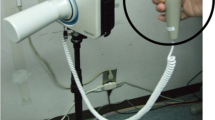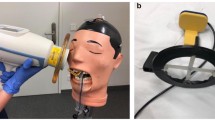Abstract
In this work, an open beam-limiting device, consisting of a rectangular collimator to be coupled to an intraoral dental X-ray device, was made using recycled lead sheets as a radiation-absorbing element. The collimator was designed for 3D printing, and using Spektr 3.0 software, the number of lead sheets needed to absorb excess radiation was calculated. The rectangular collimator reduced the radiation dose to patients by 65% when using four layers of recycled lead sheets (saturating with a 70% reduction in radiation dose at the limit of eight or more sheets of lead). The rectangular collimator does not negatively impact the quality of the radiological image, is available as an open design for 3D printing, and can be built with materials that are easily accessible to the dentist, facilitating its use in clinical practice and reducing the patient’s exposure to ionizing radiation.





Similar content being viewed by others
References
White SC, Mallya SM. Update on the biological effects of ionizing radiation, relative dose factors and radiation hygiene. Aust Dent J. 2012;57(Suppl 1):2–8. https://doi.org/10.1111/j.1834-7819.2011.01665.x.
Brasil. Ministério da Saúde. RESOLUÇÃO - RDC Nº 611, DE 9 DE MARÇO DE 2022. Brasília, DF: Diário Oficial da União; 2022. https://www.in.gov.br/web/dou/-/resolucao-rdc-n-611-de-9-de-marco-de-2022-386107075. Accessed 30 Aug 2023.
International Commission on Radiological Protection (ICRP). Recomendations of the ICRP. ICRP Publication 103. Ann ICRP. 2008;37:2–4.
International Atomic Energy Agency. IAEA safety standards for protecting people and the environment. Radiation protection and safety of radiation Sources: international basic safety standards. General safety requirements part 3. Vienna: IAE; 2014.
Van Acker JWG, Pauwels NS, Cauwels RGEC, Rajasekharan S. Outcomes of different radioprotective precautions in children undergoing dental radiography: a systematic review. Eur Arch Paediatr Dent. 2020;21(4):463–508. https://doi.org/10.1007/s40368-020-00544-8.
Lorenzoni DC, Bolognese AM, Garib DG, Guedes FR, Sant’anna EF. Cone-beam computed tomography and radiographs in dentistry: aspects related to radiation dose. Int J Dent. 2012;2012:813768. https://doi.org/10.1155/2012/813768.
Benn DK, Vig PS. Estimation of x-ray radiation related cancers in US dental offices: is it worth the risk? Oral Surg Oral Med Oral Pathol Oral Radiol. 2021;132(5):597–608. https://doi.org/10.1016/j.oooo.2021.01.027.
Johnson KB, Ludlow JB. Intraoral radiographs: a comparison of dose and risk reduction with collimation and thyroid shielding. J Am Dent Assoc. 2020;151(10):726–34. https://doi.org/10.1016/j.adaj.2020.06.019.
Hoogeveen RC, de Randamie TI, Soemodihardjo GM, Berkhout W. Ambient dose during intraoral radiography with current techniques: Part 1 conversion factor for scattered radiation using a rectangular collimator. Dentomaxillofac Radiol. 2018;47(7):20180108. https://doi.org/10.1259/dmfr.20180108.
Campbell RE, Wilson S, Zhang Y, Scarfe WC. A survey on radiation exposure reduction methods including rectangular collimation for intraoral radiography by pediatric dentists in the United States. J Am Dent Assoc. 2020;151(4):287–96. https://doi.org/10.1016/j.adaj.2020.01.014.
Shetty A, Almeida FT, Ganatra S, Senior A, Pacheco-Pereira C. Evidence on radiation dose reduction using rectangular collimation: a systematic review. Int Dent J. 2019;69(2):84–97. https://doi.org/10.1111/idj.12411.
Magill D, Ngo NJH, Felice MA, Mupparapu M. Kerma area product (KAP) and scatter measurements for intraoral X-ray machines using three different types of round collimation compared with rectangular beam limiter. Dentomaxillofac Radiol. 2019;48(2):20180183. https://doi.org/10.1259/dmfr.20180183.
Punnoose J, Xu J, Sisniega A, Zbijewski W, Siewerdsen JH. Technical Note: spektr 3.0-A computational tool for x-ray spectrum modelling and analysis. Med Phys. 2016;43(8):4711. https://doi.org/10.1118/1.4955438.
Parrott LA, Ng SY. A comparison between bitewing radiographs taken with rectangular and circular collimators in UK military dental practices: a retrospective study. Dentomaxillofac Radiol. 2011;40(2):102–9. https://doi.org/10.1259/dmfr/86968802.
Senior A, Tolentino Almeida F, Geha H, Pachêco-Pereira C. Intraoral imaging in dental private practice—a rectangular collimator study. J Can Dent Assoc. 2020;86:k16.
Thingiverse, thing:5841403. https://www.thingiverse.com/thing:5841403. Accessed 07 Fev 2023.
Acknowledgements
The support from the Brazilian Government Agency Conselho Nacional de Desenvolvimento Científico e Tecnológico (CNPq)—grant 305528/2018-1 is gratefully acknowledged. This study was also financed in part by the Coordenação de Aperfeiçoamento de Pessoal de Nível Superior—Brasil (CAPES)—Finance Code 001. Thanks are due to Luiza F. Lima for X-ray fluorescence analysis of the lead sheets, and the Manufacturing Laboratory of Federal Institute of Rio Grande do Sul—Caxias do Sul, where the collimator parts were 3D printed.
Funding
This study was supported by Conselho Nacional de Desenvolvimento Científico e Tecnológico (CNPq)—Grant 305528/2018-1, and Coordenação de Aperfeiçoamento de Pessoal de Nível Superior—Brasil (CAPES)-Finance Code 001.
Author information
Authors and Affiliations
Contributions
MCP: conceptualization, methodology, investigation, writing—original draft preparation. ET: conceptualization, investigation, writing—original draft preparation, writing (review and editing). TOG: data curation, investigation, writing (review and editing). JEZ: conceptualization, methodology, data curation, writing (review and editing). CAP: conceptualization, methodology, data curation, writing—original draft preparation, writing (review and editing). All authors read and approved the final manuscript.
Corresponding author
Ethics declarations
Conflicts of interest
The authors declare that they have no conflict of interest.
Ethical approval
Not applicable.
Additional information
Publisher's Note
Springer Nature remains neutral with regard to jurisdictional claims in published maps and institutional affiliations.
About this article
Cite this article
Poletto, M.C., Thomazi, E., Zorzi, J.E. et al. Development of an open project rectangular collimator for use with intraoral dental X-ray unit. Radiol Phys Technol 17, 315–321 (2024). https://doi.org/10.1007/s12194-023-00772-9
Received:
Revised:
Accepted:
Published:
Issue Date:
DOI: https://doi.org/10.1007/s12194-023-00772-9




